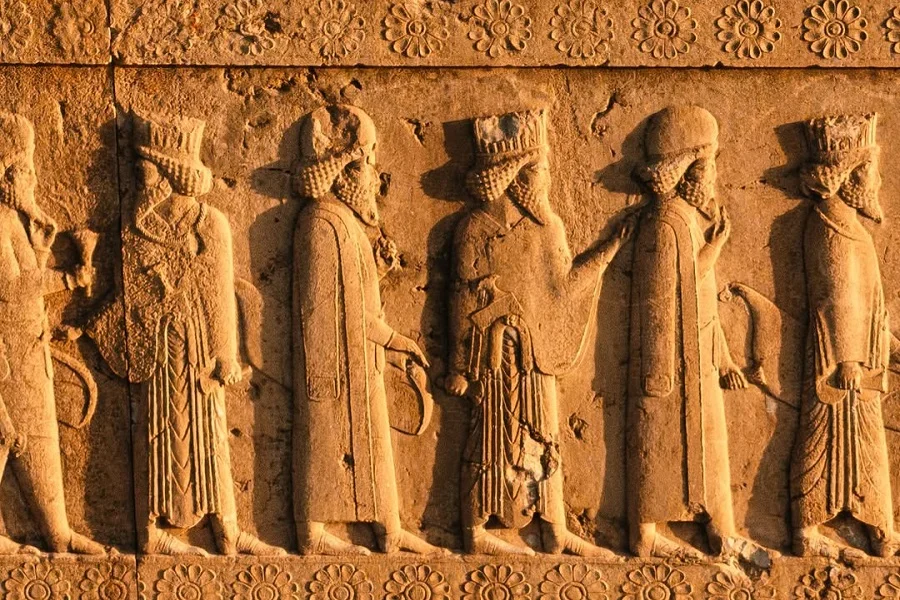
Where is Persia Now?
“Persia” and “Iran” refer to the same country. The name “Iran” has been used for thousands of years by its people, while “Persia” was more common in the West.
So Why did Persia switch to Iran? In 1935, Reza Shah asked the world to officially use “Iran” to reflect the country’s true identity. So, both names describe the same rich and ancient civilization.
History Of Persia
The Achaemenid Empire: The First Persian Empire
The Achaemenid Empire (550–330 BC), founded by Cyrus the Great, was the world’s first great empire, stretching from Egypt to India.
Cyrus expanded the empire peacefully and allowed different cultures to coexist. His successor, Darius the Great, built the famous Royal Road and organized the empire into provinces called satrapies for easier rule.
Despite its power, internal conflicts weakened the empire, and Alexander the Great conquered it in 334 BC. The Achaemenids are remembered for their organization, tolerance, and strong infrastructure.
The Parthian Empire
After Alexander’s fall, the Parthians rose to power around 247 BC. They built a strong empire that lasted almost 500 years and often fought with Rome for control of the region.
Kings like Mithridates I and Mithridates II expanded the empire and made it a powerful state stretching to Mesopotamia. The Parthians were skilled horsemen and used fast cavalry in battles, famously defeating the Romans at the Battle of Carrhae in 53 BC.
Their flexible rule, where local kings had some freedom under the “King of Kings,” helped them govern a vast land.
The Sassanid Empire: The Last Great Persian Dynasty
The Sassanid Empire (224–651 AD) restored Persian power and became Rome’s main rival. Founded by Ardashir I, it reached its height under Khosrow I and Khosrow II, who expanded the empire into Syria, Palestine, and Egypt.
The Sassanids built a strong government, encouraged trade along the Silk Road, and developed Persian art and architecture. However, constant wars and the rise of Islam led to their fall after the death of the last king, Yazdgird III, in 651 AD.
Persia’s Enduring Legacy
From the Achaemenids to the Sassanids, Persia shaped world history through its culture, administration, and respect for diversity. Modern Iran still carries the spirit and pride of this ancient civilization.
Geography of Persia
Iran is a land of contrasts: deserts, mountains, forests, and seas all meet here. It’s the second-largest country in the Middle East, bordered by 15 neighbors by land and sea. The Zagros Mountains stretch across the west, while the Alborz range in the north is home to Mount Damavand, the highest peak in the Middle East. In the center lies the vast Dasht-e Kavir and Dasht-e Lut deserts, known for their otherworldly beauty. To the north, Iran touches the Caspian Sea, with green forests and rice fields, while to the south it meets the Persian Gulf and the Gulf of Oman, famous for warm beaches and colorful islands like Qeshm and Hormuz. Iran’s geography shapes its people’s way of life, from snowy winters in the mountains to sunny days in the desert, offering a diversity few countries can match
Culture & Religion in Persia
Iran’s culture is as rich and colorful as its landscapes. It’s one of the world’s oldest civilizations, with traditions that go back thousands of years. Persians are known for their warm hospitality, poetry, art, and deep respect for family and community. Festivals like Nowruz (Persian New Year) and Yalda Night bring people together to celebrate light, renewal, and joy.
Religion also plays an important role in daily life. Most Iranians are Muslim, mainly following Shia Islam, but there are also Christians, Jews, Zoroastrians, and Armenians, all living peacefully across the country. Ancient Persian values such as kindness, honesty, and respect for nature still influence Iranian life today. Whether through music, traditional tea gatherings, or the beauty of Persian carpets and calligraphy, Iran’s culture reflects a blend of history, faith, and a deep love for life.
Persia Beyond the Name
Iran is more than the memory of ancient kings and empires; it’s a country that has learned to reinvent itself through every era. Its people have faced invasions, revolutions, and rapid change, yet the core idea of “being Persian” has never disappeared. What connects the past and present isn’t just history, but a shared sense of creativity, endurance, and curiosity.
Persia lives not only in museums or ruins but in the rhythm of life, in modern architecture that echoes old patterns, in new art that carries old meanings, and in conversations where tradition and modern thought meet. Understanding Iran means seeing how an ancient culture continues to question, adapt, and move forward, quietly but confidently, just as it has for thousands of years.
FAQs about Persia and Iran
1. Are Persia and Iran the same country?
Yes. Persia is the historical name of Iran. Since 1935, the name “Iran” has been officially used, but both refer to the same land and people.
2. Why did the name change from Persia to Iran?
Reza Shah requested that the world use “Iran” to reflect the country’s true cultural identity and heritage.
3. What language do people speak in Iran?
The main language is Persian (Farsi), but many ethnic groups also speak local languages such as Kurdish, Azeri, Arabic, and Balochi.
4. Is Iran safe for tourists?
Yes, Iran is one of the safest countries in the world. Visitors often say they feel very welcome thanks to the kindness of local people.
5. What is the main religion in Iran?
Most Iranians follow Shia Islam, but there are also small communities of Christians, Jews, and Zoroastrians.
6. What is Iran famous for?
Iran is known for its ancient history, Persian architecture, poetry, carpets, delicious cuisine, and warm hospitality.
7. When is the best time to visit Iran?
Spring (March to May) and autumn (September to November) are the best seasons, offering pleasant weather across most parts of the country.

